Futures Jump After Nvidia's Blowout Earnings Calm Nerves; All Eyes On Delayed Payrolls
The AI euphoria, which defined markets for much of 2025 but went AWOL a month ago, is back if only for the time being as Nvidia’s blowout earnings and strong forecast, coupled with cautious positioning before the results, is spurring a relief rally. The results won’t erase all the concerns about AI circularity, but Jensen Huang’s view of the AI economy is taking precedence today. Focus later will turn back to macro data (or lack of it) and the Fed. Until then, US equity futures are sharply higher following the biggest wall of worry into year-end: as of 8:00am ET, S&P futures are up 1.3%, and Nasdaq futures surge 1.6%. If those gains hold, both gauges will move back above their key 50-day moving averages. In the premarket, NVDA (+5%) leading all stocks higher and Mag7, Semis, and AI Themes including recent laggards all rallying (ORCL +3%, CRWV +8%). Cyclicals are rallying ex-Materials and Defensives (ex-HC) poised to have a down day. Bond yields are mixed, from +1 to -1bp and the USD indicated a touch higher. Commodities are mixed with Ags rallying, WTI above $60, and Metals coming for sale. The macro data focus today is on the delayed release of the Sept payrolls (the only jobs data until the Dec 10 FOMC meeting), as well as new jobless data (our NFP preview is here). JPM's "TL/DR" is that the investment hypothesis remains intact and that a Fed cut is unnecessary to making new ATHs.
In premarket trading, Nvidia (NVDA) gains 4.8%, outperforming fellow Magnificent Seven stocks after delivering a strong revenue forecast. All other Mag 7s are also green (Tesla +2%, Alphabet +1.9%, Amazon +1.4%, Meta Platforms +1.3%, Microsoft +1%, Apple +0.4%).
- AI-related stocks rally after Nvidia’s quarterly update eased concerns that had spread across the sector.
- Atkore (ATKR) falls 11% after the maker of electrical products gave a forecast for 2026 adjusted earnings per share with a midpoint below analysts’ expectations. The company also reported gross margin and adjusted EPS below expectations in the fourth quarter.
- Bath & Body Works Inc. (BBWI) drops 13% after cutting its full-year outlook, saying weak consumer sentiment is hurting shoppers’ willingness to spend and the expected impact of tariffs imposed by the US and other countries.
- NetEase US-listed shares (NTES) decline 3% after the Chinese internet giant reported adjusted net income from continuing operations per ADS for the third quarter that missed the average analyst estimate.
- PACS Group (PACS) soars 40% after the nursing home operator said its restatements and audit committee investigation are now complete. The company also posted third-quarter revenue that grew 31% from the year-ago period.
- Palo Alto Networks (PANW) falls 3.6% after the network security software company reported its first-quarter results and gave an outlook. It also announced that it is acquiring Chronosphere Inc. for $3.35 billion.
- Regeneron Pharmaceuticals (REGN) rises 3.2% after the FDA approved EYLEA HD, an injectable drug to treat patients with macular edema following retinal vein occlusion.
- Walmart (WMT) slips 1% even though the retailer increased its sales outlook for the full year. The CFO said consumer spending has been largely consistent, though there’s “some slight moderation” within lower-income households. Middle- and higher-income shoppers aren’t pulling back.
- ZIM Integrated Shipping Services Ltd. (ZIM) rises 2% after the company narrowed its adjusted Ebitda forecast for the full year.
In corporate news, a Chinese investment firm bought a block of shares in TikTok parent ByteDance at a valuation of $480 billion, far above recent levels. Netflix is said to have told the management of Warner Bros. Discovery that it will keep releasing the studio’s films in theaters if it’s successful in buying the company. Bayer won US approval for its new medicine Hyrnuo to treat a common form of lung cancer.
Bulls have Nvidia to thank for today's solid green screens. Nvidia surged more than 4% in premarket trading, spurring gains in other AI shares including AMD and Broadcom. Strong results from the AI bellwether helped restore a sense of calm after weeks of heavy selling in technology stocks. Wall Street had grown uneasy about stretched valuations and the vast sums being spent on AI infrastructure after the sector powered a nearly 40% rally in the S&P 500 since its April low.
In his discussion of earnings, Nvidia’s CEO addressed the debate over an AI bubble, saying that “we see something very different.” Noted short seller, Muddy Waters’ Carson Block, meanwhile, warned that betting against the biggest US tech names won’t end well, while “AI-adjacent companies, AI pretenders” may be the place to be short, although that could still be a dangerous trade.
Following a retreat of as much as 10% since the start of the month, Nvidia’s latest results rewarded shareholders’ faith and drew a warning from short-seller Carson Block, who said that “you’re not going to be in business very long” betting against the biggest technology stock.
“Nothing stands in the way of a Christmas rally now,” said Amundi SA Chief Investment Officer Vincent Mortier. “Everything is lining up for the cycle to continue in the short term.”
Outside of tech, things aren’t quite so cheerful. The much-delayed September payrolls report is due to be published later, and it’ll be the only official major jobs data published before Fed policymakers meet in December. Odds of a rate cut have steadily slipped in recent weeks, with the market now seeing about a 25% probability of a reduction.
Cracks in the bullish narrative are appearing elsewhere. A portfolio of private credit loans managed by BlackRock has performed so poorly that the money manager has waived some management fees. Bitcoin’s latest rout has led to a wipeout of more than $1 trillion across the digital‑asset world. And Amundi CIO Vincent Mortier warned of the possibility of “too much hype” around Nvidia.
With the first of the week’s key events spurring a comeback for equities, attention is now turning to the path for interest rates as markets await the release of the September jobs report. The figures will be the only major labor market data published before the Federal Reserve’s next policy meeting. Forecasts are largely unchanged from those held before the original release date and may be stale. September payrolls are expected to rise by 51,000, up from Augustʼs 22,000, with a huge gap in estimates, ranging from a decline of 20,000 to a gain of 105,000 (Goldman is above consensus (80K), while JPM is just below the consensus print (50K) - our preview is here).
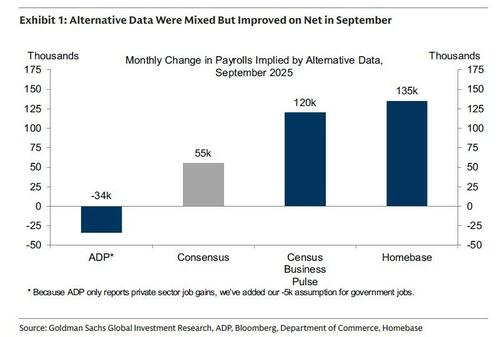
"I’d wager that the ‘Goldilocks’ zone for the payrolls print is probably 30,000 to 70,000, which would keep a cut on the cards, but also point to the labor market remaining resilient enough not to trigger undue concern,” according to Pepperstone.
“The September jobs data is clearly dated,” said Wolf von Rotberg, equity strategist at Bank J Safra Sarasin. “They would thus need to show a substantial surprise to the upside or the downside. A significant downside surprise would likely have more of an impact on markets.”
The Bureau of Labor Statistics said it won’t publish an October jobs report, but will incorporate those payroll figures in the November data due after the Fed’s final meeting of the year. Meanwhile, minutes from the Fed’s October meeting showed many officials considered it appropriate to keep rates steady for the remainder of 2025. As a result, traders have steadily dialed back bets on a December rate cut amid hawkish remarks from policymakers and a lack of data, with money markets now pricing in about a 25% chance of easing
A rally into year-end is in sight if the market holds on to its early gains through the rest of the day, said Guy Miller, chief strategist at Zurich Insurance Group. “I want to see it closing today on strength,” Miller said. “That will be indicative of investors buying the dip and on board with the tech story. Where we close today will be telling whether the risk-on trade is back or not.”
European stocks join the global equity rally and are set to snap a five-day losing streak after Nvidia’s surprisingly strong revenue forecast. The Stoxx 600 is up 0.9% with technology, industrial and bank shares leading gains. Here are the biggest movers Thursday:
- European defense stocks gain on Thursday after JPMorgan analysts said Wednesday’s steep declines were a “significant over-reaction” and provide a “compelling entry point into the sector.”
- BNP Paribas shares advance 6%, the best performer on the Stoxx 600 Banks Index, after the French lender announced a new €1.15 billion buyback and plans to reach a target for capital strength early
- Games Workshop shares rise as much as 11%, after the maker of the Warhammer tabletop game released a 1H trading update that Jefferies described as “outstanding”
- Halma climbs as much as 11%, hitting a record high, after increasing guidance for the full year and delivering first-half results above expectations
- Wartsila gains as much as 8.9%, after the company announced it will deliver 27 engines to provide continuous primary power for a new data center under construction in the US
- Elior surge as much as 20%, the biggest rise since May 2024, after the French catering and food services company said it would reinstate dividend payments
- Allegro drops as much as 6.3% as weaker sales in November clouded 3Q earnings beat. Poland’s biggest ecommerce platform trimmed its gross merchandise value guidance for the full year, triggering negative market reaction
- Renk shares fall as much as 8.4% to the lowest since May as the German defense name hosts an investor day. Jefferies points out that the 2027 and 2028 outlooks might be a bit underwhelming
- JD Sports shares drop as much as 2.4% this morning after the apparel retailer warned annual profit before tax and adjusting items will be at the lower end of market expectations
- Soitec slumps as much as 14%, dropping to the lowest since January 2017, after the French chip material company revealed guidance for third-quarter revenue growth which is significantly below expectations
Earlier in the session, Asian stocks climbed the most in three weeks, boosted by gains in technology shares after a stellar earnings forecast from Nvidia Corp. alleviated fears of an artificial intelligence spending bubble. The MSCI Asia Pacific Index rose as much as 1.7%, the biggest jump since Oct. 27. Most markets in the region were in the green, with tech-heavy benchmarks in Japan, Taiwan and South Korea leading gains. India’s NSE Nifty 50 Index is set for a new record high. Mainland Chinese shares closed lower, though property stocks got a lift after policymakers are said to be considering new measures to turn around the struggling market.
In FX, the Bloomberg Dollar Spot Index is little changed. The pound and kiwi are in top spots among the G-10 currencies, rising 0.2% each. The yen pared an earlier fall.
In rates, treasuries are steady after Thursday’s fall, with US 10-year yields flat at 4.14%. Two-year borrowing costs add 1 bp to 3.60%. Bunds and gilts also tread water. Yields on Japan’s five- and 10-year government bonds rose to their highest levels since 2008, while 20 and 40-year yields soared to record highs, as markets brace for Prime Minister Sanae Takaichi’s stimulus package, which is set to be unveiled on Friday. Treasury sells $19 billion of 10-year TIPS in a reopening at 1pm; 20-year new-issue auction drew solid demand Wednesday. Focal points of Thursday’s session include the delayed release of September employment data and several speeches by Fed officials.

In commodities, spot gold falls $15 to around $4,063/oz. Oil prices extend gains after the Kremlin said they are not holding consultations with the US about ending the war in Ukraine. WTI January crude futures rise 0.8% to $59.75 a barrel. Bitcoin is up 1.5% near $92,000.
The US economic calendar also includes weekly jobless claims, November Philadelphia Fed business outlook (8:30am), October existing home sales (10am) and November Kansas City Fed manufacturing activity (11am). Fed speaker slate includes Hammack (8:45am), Barr (9:30am), Cook (11am), Goolsbee (12:40pm and 6pm), Miran (6:15pm) and Paulson (6:45pm)
Market Snapshot
- S&P 500 mini +1.3%,
- Nasdaq 100 mini +1.6%,
- Russell 2000 mini +0.8%
- Stoxx Europe 600 +0.8%,
- DAX +0.9%,
- CAC 40 +0.8%
- 10-year Treasury yield little changed at 4.13%
- VIX -2.7 points at 20.99
- Bloomberg Dollar Index little changed at 1225.22,
- euro little changed at $1.1527
- WTI crude +1% at $60.04/barrel
Top Overnight News
- Trump posted that he signed the bill approving the release of the Epstein files: Truth Social.
- Trump is set to meet New York City Mayor Mamdani on Friday at the Oval Office: Truth Social.
- Trump is reportedly considering an executive order to pre-empt state AI laws: Reuters
- Trump plans to roll out a “Genesis Mission” to boost US AI development, giving it the same importance as the Manhattan Project or the space race. BBG
- President Trump has repeatedly floated the idea of $2,000 payments to low- and middle-income households, funded by revenue from his tariffs. GOP lawmakers are lukewarm at best about approving any $2,000 checks, calling into question whether Trump can secure the congressional approval needed to get the cash to Americans as he has promised. WSJ
- The US approved the export of tens of thousands of advanced AI chips to Saudi Arabia’s Humain and the UAE’s G42. BBG
- Canada and the US still have a chance to reach an agreement to reduce tariffs despite last month’s diplomatic blowup, Trump’s envoy in Ottawa said. BBG
- China is considering new measures to support its struggling property market, including providing mortgage subsidies for new homebuyers and raising income tax rebates for mortgage borrowers. The plan aims to stabilize the housing market, which has seen a slump in sales and prices, and to prevent a further weakening of the sector from threatening the country's financial system. BBG
- Japan's government is in the final stages of assembling a stimulus package worth 21.3 trillion yen ($135.38 billion) to help households cope with persistent inflation, a draft seen by Reuters showed, in what would be the largest stimulus since the COVID pandemic. RTRS
- BOJ board member Junko Koeda signaled a rate hike is possible as soon as December. Separately, Japan’s chief cabinet secretary warned that the yen is experiencing sudden and one-sided moves. BBG
- The U.S. has signaled to President Volodymyr Zelenskiy that Ukraine must accept a U.S.-drafted framework to end the war with Russia that proposes Kyiv giving up territory and some weapons, two people familiar with the matter said on Wednesday. RTRS
- Cash flows and balance sheet capacity are unlikely to constrain large public AI hyperscaler capex spending in 2026, according to Goldman. The hyperscalers spent $107 billion in capex in 3Q 2025, including AI and non-AI expenditures, representing a year/year growth rate of 76%. Analysts expect this growth rate will slow sharply to 53% in 4Q 2025 and further to 25% by the end of 2026. However, analysts have been consistently too conservative with their estimates during the past two years. The magnitude of spending in historical technology investment cycles suggests upside to spending estimates today. The recently demonstrated willingness of the large public hyperscalers to employ the strength of their balance sheets in funding capex also indicates upside to consensus estimates: GS
- UBS executive says US inflation is quite sticky, upcoming quarters is probably going to be a little bit challenging from a macro standpoint.
- BofA Total Card Spending (w/e 15th Nov) +1.5% (prev. +4.2%, Oct avg. +2.4%); notes that "as we approach the holiday seasons, spending per household on holiday items is tracking significantly ahead of 2023 and 2024 levels".
NVDA Commentary Highlights:
- CEO on AI bubble: CEO Huang says there has been a lot of talk about an AI bubble but "we see something different."
- CFO on China: Will continue to cooperate on China. Sizeable purchase orders for H20 AI chip never materialised in the quarter due to geopolitical issues and the increasingly competitive market in China. Not expecting data-centre-compute revenue from China in Q4.
- CEO Comments: NVIDIA has done a really good job in terms of planning and supply chains. NVIDIA will continue to do stock buybacks. More successful this year vs last year.
- CFO Comments: Still in early innings. Reiterates visibility into USD 500bn Blackwell and Rubin revenue. Cloud services are sold out. Demand continues to exceed expectations.
Trade/Tariffs
- US lawmakers are reportedly considering a new bill to codify China AI chip export curbs, according to Bloomberg sources; the White House has reportedly asked Congress to reject the bill curbing NVIDIA (NVDA) exports.
- US Commerce Department plans to approve export of 70,000 advanced AI chips to UAE and Saudi Arabia, according to WSJ sources; Export deal includes approval for NVIDIA's (NVDA) GB300 or equivalent chips.
- China’s October rare earth magnet exports to the US rose 56.1% from September, according to customs data.
- European Commission will, on Monday, present a list of sectors it wishes to be exempt from US tariffs to US Commerce Secretary Lutnick and USTR Greer, via Politico citing sources; includes medical devices, wines, spirits, beers & pasta
A more detailed look at global markets courtesy of Newsquawk
APAC stocks surged across the board, buoyed by a strong performance in the tech sector following NVIDIA’s solid earnings and guidance, while CEO Huang dismissed concerns of an AI bubble, stating, “We see something different.” ASX 200 held near highs, supported by strength in tech and gold sectors. Nikkei 225 surged at the open and reclaimed 50,000+ levels as NVIDIA boosted tech stocks, though it pulled back from highs amid ongoing US-China tensions and fiscal concerns and as JGB yields continued climbing. Hang Seng and Shanghai Comp both opened firmer but lagged peers, with China struggling to capitalise on NVIDIA’s performance amid the US/China AI race. Some modest upside was seen on reports that China is reportedly mulling new property stimulus with mortgage subsidies, according to Bloomberg sources. Meanwhile, the PBoC held LPRs steady as expected.
Top Asian News
- China is reportedly mulling new property stimulus measures, including mortgage subsidies, according to Bloomberg sources.
- Japan's economic stimulus package is expected to be around JPY 21.3tln, according to NHK. The Japanese government is in the final stages of compiling its economic stimulus package worth JPY 21.3tln, according to a draft seen by Reuters; the package will total JPY 42.8tln, including private-sector investments.
- BoJ Board Member Koeda said the BoJ is ready to step into market via increase in bond buying and emergency market operations when long-term yields make rapid moves; want to closely watch how FX volatility could affect prices; no comment on specific long-term rate level; should be set by markets reflecting fundamentals
- BoJ Board Member Koeda said the bank must normalise interest rates to avoid causing distortion in the future, adding that she believes underlying inflation is about 2%. She reinforced a data-dependent approach.
- Japanese Chief Cabinet Secretary Kihara said the government is watching market moves, including the bond market, closely and expressed concern about recent sharp, one-sided FX moves. He emphasised that the FX market needs to move stably, reflecting fundamentals, and that the government is watching FX with a high sense of urgency.
- Japanese Finance Minister Katayama said she won’t comment directly on JGB yield levels, which are determined by various factors, and reaffirmed with BoJ Governor Ueda yesterday that authorities will watch market moves with a strong sense of urgency.
- RBA's Hunter said monthly inflation data can be volatile and that the bank will not react to just one month of data; he also noted that the response in the housing market to rate cuts has been a little stronger than expected.
- Chinese Loan Prime Rate 1Y (Nov) 3.00% vs. Exp. 3.00% (Prev. 3.00%); 5Y 3.50% vs. Exp. 3.50% (Prev. 3.50%)
- BoJ Governor Ueda is to set to attend a lower house Finance Committee on Friday 21st November, via Reuters citing parliamentary sources.
- Chinese Commerce Ministry on Japanese Trade ties says if Japan insists on going down the wrong path then China will take the necessary measures. Says Japan's PM Takaichi remarks have a great impact on bilateral trade cooperation. Tokyo should create favourable environment for economic trade cooperation.
- BoJ Ueda to appear at a Financial Times event on the December 9th.
European bourses (STOXX 600 +0.7%) opened entirely in the green, with sentiment boosted following strong earnings from NVIDIA. Price action today has been fairly sideways at elevated levels as markets await US NFP later. European sectors hold a strong positive bias. It is no surprise that Tech is at the top of the pile, in tandem with pre-market gains in NVIDIA (+5%). The likes of ASML (+1.4%) and Infineon (+1.5%) both move higher.
Top European News
- ECB's Makhlouf says he is comfortable with where policy is and needs further evidence to change his view; outcomes in line with projections, and new projections are unlikely to change. Should be very cautious about reacting to small deviations in projections. Risks around inflation outlook are balanced. Completely relaxed about undershooting next year, inflation will come back.
FX
- DXY is a little firmer today and currently trading towards the upper end of a 100.10 to 100.32 range. From a technical standpoint, the index topped its 200 DMA at 99.91 in the prior session and has continued to rise to a multi-month high – levels not seen since late-May’25. Upside today facilitated by a hawkish leaning FOMC Minutes, and the BLS announcing that the October and November NFP reports will be till December 16th - notably leaving the Fed with only today's (Sept) NFP report. As it stands money markets currently price in a near-25% chance of a cut at the December meeting.
- EUR is a little weaker vs the Dollar, and as has been the case in recent weeks, a real lack of European specific data to help guide the Single-Currency in any direction. As such, much of the price action has been dictated by the Dollar side of the pair, and will ultimately await the NFP report today. Worth highlighting German Producer Prices data which printed more-or-less in-line, and ultimately had limited impact on the pair.
- USD/JPY has continued its ascent beyond the 157.00 mark in overnight trade, to top the 157.50 mark and make a fresh session high of 157.77. Worth noting that the pair has been subject to moves on both sides, with USD gaining amidst a hawkish repricing into the December meeting, whilst JPY has had domestic factors to digest. Overnight, Katayama was back on the wires where she once again attempted some verbal intervention, but to no effect – the pair continued to edge higher. As the European morning progressed, the pair has cooled from best levels, to currently trade at 157.20, but still very much at the upper end of Wednesday’s confines.
- A quiet session for the GBP this morning, with little fresh newsflow from a Budget perspective. Cable currently resides in a 1.3039 to 1.3076 range. The GBP has been subject to some selling pressure over the course of the past month, with losses totalling roughly 3% - this comes amidst Budget related jitters as Chancellor Reeves chops and changes her thoughts on the best approach. Moreover, the recent political uncertainty within the Labour party has added to the risk premium. Scheduled speakers today include Dhingra and Mann.
- Antipodeans trade mixed, with the Kiwi benefiting from the risk-tone whilst the Aussie is flat and essentially conforms to the subdued risk tone in China overnight, hit by their status in the AI race post-NVIDIA; moreover, base metals are generally softer across the board. For China specifically, no major move was seen on reports that China is reportedly mulling new property stimulus. AUD/USD trades within a 0.6472 to 0.6491 range whilst NZD/USD trades in a 0.5596 to 0.5614 confine.
Fixed Income
- JGBs are pressured overnight as Japanese yields continue to climb. JGBs themselves to a 134.56 trough, marking a new contract low. As such, the 10yr yield has risen to a 1.85% peak, taking us back to levels from early 2008. Action that has been driven by ongoing speculation and reporting around the upcoming stimulus. The latest reporting suggests an outlay of around JPY 17tln, far exceeding the JPY 13.9tln figure from the last package. Updates that have pressured JGBs given an expectation for it to necessitate greater issuance than the JPY 6.7tln figure outlined last time.
- USTs are under pressure, but only modestly so. Downside comes given the upbeat risk tone after NVIDIA numbers (see Equities). Additionally, the latest FOMC minutes showed a somewhat divided board but the undertones were hawkish. Potentially more pertinently, the BLS has confirmed the October payrolls release will not print in full (no unemployment rate) while the November series has been delayed until after the December meeting. Factors that are both hawkish/bearish. As the lack of data visibility gives the Fed theoretical scope to wait-and-see how the economy is faring before easing further; reminder, in October, Powell remarked, “when there is fog, you could slow down”. Given all this, USTs are in the red and down to a 112-18 base. Support comes into play at 112-17 from Tuesday before Monday’s 112-15+ WTD low.
- Bunds are softer, following the risk tone lower and posting downside of just under 20 ticks at most. Holding around a 128.48 low, if the move continues, we look to 128.25 from early October before the figure and then touted support at 127.88. Specifics for the bloc are somewhat light thus far. No move to ECB’s Makhlouf this morning, remarks that chimed with the market view that the ECB is at a terminal. Interestingly, Makhlouf said he does not think the new projections are likely to change; a remark in reference to the December forecast round which will include the first look at 2028, a period in focus and of particular note for those looking for further ECB easing. Supply from Spain passed without incident, whilst France was a little more mixed. Overall though, no move seen and OATs trade in-line with Bunds as we approach the tail-end of the week where attention returns back to French budget deliberations.
- Gilts are marginally outperforming after the underperformance on Wednesday. Underperformance that was seemingly due to concerns around the stability of Labour leadership amid mounting challenges to PM Starmer in the background. A challenge that would be a knock to the relatively, market-favourable pairing of Starmer and Reeves. This morning, Gilts are holding in the green by a handful of ticks. Initially opened lower acknowledging the bearish bias seen in peers but then swiftly pared to post gains of 15 ticks at best. Overall though, the benchmark has settled just above the unchanged mark in a 91.51-85 band. Scheduled speakers today include Dhingra and Mann.
Commodities
- Crude benchmarks have traded subdued to start the European session despite the positive risk tone following NVIDIA earnings and further reporting about the proposed 28-point plan to end the war in Ukraine. After grinding higher throughout Wednesday's US session, WTI and Brent pulled back to a trough of USD 59.27/bbl and USD 63.52/bbl respectively before extending to session highs of USD 59.80/bbl and USD 64.08/bbl as European traders stepped into the market. Despite the muted trade, benchmarks currently remain near session highs as the European session continues. Some further upside seen following comments via Russia's Kremlin which said that consultations with the US on peace are not taking place, but contacts are.
- Spot XAU sold off at the start of the APAC session and has continued to drift lower following the hawkish FOMC minutes and the bid seen across global equities as NVIDIA posted positive earnings. After a slight bid to a peak of USD 4110/oz at the start of APAC trade, XAU sold off to a trough of USD 4042/oz before consolidating in a USD 4042-4085/oz band. As the European session got underway, the yellow metal briefly extended to a new session low of USD 4039/oz before bouncing back into the earlier band.
- Base metals have traded rangebound to start the European session despite the positive global risk tone, outside of China, following NVIDIA earnings. 3M LME Copper started positive and bid higher to a peak of USD 10.83k/t at the start of APAC trade. However, the red metal fell lower and as the European session got underway, copper extended losses to a trough of USD 10.72k/t. Thus far, 3M LME Copper has managed to bounce off worst levels and is currently trading at USD 10.80k/t.
- Offshore Alliance Union applied to the Australian tribunal for permission to go on strike at Woodside’s (WDS AT) Pluto 2 LNG project.
Geopolitics
- Russia said it is ready for dialogue with the United States on nuclear arms reduction, via Al Arabiya.
- US President Trump reportedly quietly approved a peace plan between Russia and Ukraine earlier this week, according to NBC.
- Russia's Kremlin says consultations or negotiations with the US on peace in Ukraine are not talking place but contacts are, adds that there is nothing to say on if President Putin has been briefed on the peace plan.
US Event Calendar
- 8:30 am: Nov 15 Initial Jobless Claims, est. 227k
- 8:30 am: Nov 8 Continuing Claims, est. 1950k
- 8:30 am: Sep Change in Nonfarm Payrolls, est. 51k, prior 22k
- 8:30 am: Sep Change in Private Payrolls, est. 65k, prior 38k
- 8:30 am: Sep Change in Manufact. Payrolls, est. -7k, prior -12k
- 8:30 am: Sep Unemployment Rate, est. 4.3%, prior 4.3%
- 8:30 am: Sep Average Hourly Earnings MoM, est. 0.3%, prior 0.3%
- 8:30 am: Sep Average Hourly Earnings YoY, est. 3.7%, prior 3.7%
- 8:30 am: Nov Philadelphia Fed Business Outlook, est. 1, prior -12.8
- 10:00 am: Oct Existing Home Sales, est. 4.08m, prior 4.06m
- 10:00 am: Oct Existing Home Sales MoM, est. 0.49%, prior 1.5%
Central Bank speakers
- 8:45 am: Fed’s Hammack Delivers Opening Remarks
- 9:30 am: Fed’s Barr in Discussion on Artificial Intelligence
- 11:00 am: Fed’s Cook Speaks on Financial Stability at Georgetown Univers
- 12:40 pm: Fed’s Goolsbee Speaks in Moderated Discussion in Indianapolis
- 6:00 pm: Fed’s Goolsbee Speaks on PBS NewsHour
- 6:15 pm: Fed’s Miran Speaks at American Investment Council
- 6:45 pm: Fed’s Paulson Speaks on Economic Outlook
DB's Jim Reid concludes the overnight wrap
In a market baying desperately for information, today's US payrolls follows rapidly on the back of Nvidia's earnings last night and the start of the return to business as usual for US data. It's fair to say that Nvidia's results have completely changed the market mood and pushed out any bubble fears for another day. The chipmaker delivered a decent revenue beat ($57.0bn vs $55.2bn est.) and gave strong revenue guidance for the current quarter ($65bn vs $61.9bn est.). The company’s CFO suggested that Nvidia could even exceed its recent target of $500bn of revenue for the next few quarters. Its shares rose by about 5% in post-market trading last night, driving futures on the S&P 500 (+1.32%) and NASDAQ (+1.88%) markedly higher overnight. Tech stocks that have recently been weak also climbed in after hours with CoreWeave around +9% higher for example. If this Nvidia move fully materializes in the regular session today, it would go against the recent pattern I noted in the CoTD yesterday of Nvidia’s shares actually seeing pretty muted post-earnings moves since ChatGPT was launched nearly three years ago. Perhaps the difference this earnings season is that this was one of the weakest months before earnings Nvidia has had in the last three years. Normally their earnings get built up but recent bubble fears probably set a much lower bar than normal, one they comfortably cleared.
Asian equity markets are also soaring with the tech heavy KOSPI (+2.47%) and the Nikkei (+2.94%) having a strong session so far. Elsewhere, the S&P/ASX 200 (+1.20%) is also seeing noticeable gain, supported by mining stocks. Conversely, Chinese stocks are underperforming, with the CSI (+0.14%) and the Shanghai Composite (+0.08%) only edging higher but with the Hang Seng (-0.09%) lower.
Ahead of Nvidia's results, the market selloff finally began to stabilise yesterday, with the S&P 500 (+0.38%) advancing after 4 consecutive declines. The Magnificent 7 (+0.83%) and Nasdaq (+0.59%) slightly outperformed helped by Nvidia itself being up +2.85% before its earnings announcement as well as a strong gain for Alphabet (+3.00%) amid positive reviews for the new version of its Gemini AI model. Other signs of financial stress from earlier in the week also began to ease, with the VIX index (-1.03pts) falling back to 23.66pts, whilst US HY spreads tightened by -4bps. One obvious point of ongoing weakness was in crypto, where Bitcoin (-2.10%) closed at a 6-month low of $90,506, though it’s back up above $92k this morning amid the post-Nvidia rally. Also noteworthy was that Oracle 5yr CDS edged up another +2.9bps to 111bps. That may rally back a bit today though.
Yesterday’s equity gains were relatively narrow, with more than 60% of the S&P 500 constituents losing ground. Despite the S&P trading up just over a percent in the first hour of trading, we saw the index briefly dip into negative territory after news broke just after Europe closed that there now wouldn't be an October payrolls report and that the November report wouldn't be released until December 16th which is 9 days after the FOMC decision. So this reduces the data availability for the Fed before the meeting and thus makes a hold more likely. Indeed futures contracts showed that the probability of a December cut spiked lower from 47% to 27% within minutes of the BLS announcement, a huge move outside of data or speeches. It closed at 29%.
That repricing was solidified as the minutes of the October FOMC meeting showed “many” officials leaning against a December rate cut. While “several participants” said that a December rate cut “could well be appropriate”, “many participants suggested that… it would likely be appropriate to keep” rates steady into year-end. “Several” policymakers were even against the October rate cut itself, although in the end only Kansas Fed President Schmid dissented in favour of keeping rates on hold. US Treasuries had traded little changed before the minutes’ release but then lost ground, with the 2yr yield rising +1.9bps to 3.59%, whilst the 10yr yield (+2.4bps) closed at 4.14%. Yields are fairly steady overnight but with the front-end a bit higher.
The Fed minutes also confirmed that “almost all participants” supported the impending end to QT announced at the October meeting following recent tightening in money market conditions, but showed little discussion on the future path of reserve management. A more differentiated direction of central bank balance sheet policies going into 2026 is one of the themes Peter Sidorov highlights in his new global money & credit chartbook published this morning.
With Nvidia’s result out the way, attention is now quickly turning to the delayed US jobs report for September, which we were meant to have nearly 7 weeks ago. Normally, a data release for a couple of months ago wouldn’t be too impactful, but a December cut likely relies on a weak print, which is clearly possible, especially optically when the breakeven rate of payrolls is as low as it is in 2025. Remember the jobs report back on August 1, when huge downward revisions undercut the story of labour market resilience after Liberation Day, which paved the way for the Fed to resume cutting in September. In terms of this report, our US economists expect both headline and private payrolls to come in at +75k in September (consensus at +50k and +65k respectively), with the unemployment rate steady at 4.3%. So a relatively firm report if they are correct. For more info and the subsequent DB Research webinar details, click here. The Labour Department is also expected to release backfilled weekly US jobless claims data today.
Over in Europe, the main news yesterday came from the UK CPI print, which showed inflation fell a bit less than the consensus expected in October. So headline inflation was down to +3.6% (vs. +3.5% expected), whilst core CPI was at +3.4% as expected. That said, some of the details were more promising, with services CPI down to +4.5% (vs. +4.6% expected), and investors dialled up the likelihood of a Bank of England rate cut next month to 87%, up from 79% the day before. So that supported front-end gilts, but there was still a big curve steepening as doubts persisted about the fiscal situation ahead of next Wednesday’s budget. So the 10yr yield actually rose +4.9bps on the day to 4.60%, underperforming their European counterparts. Indeed the 30yr yield was up +6.3bps.
Otherwise in Europe, markets put in a steady performance across the board. So the STOXX 600 (-0.03%) barely budged, although it did mark a 5th consecutive decline for the index for the first time since June. UK equities were the main driver behind the losses, with the FTSE 100 (-0.47%) also posting a 5th consecutive decline for the first time since March. Then on the fixed income side, the major sovereign bonds saw little change, with yields on 10yr bunds (+0.5bps), OATs (+0.3bps) and BTPs (-0.4bps) barely moving.
Overnight, Junko Koeda, a board member of the BOJ, has provided one of the most explicit hawkish indications from the central bank in recent months, suggesting the potential for a rate increase as early as next month. This is in response to the yen reaching its lowest value in 10 months. However the Yen hasn't moved much and JGBs continue their recent yield march higher ahead of the arrival of the details of PM Takaichi's stimulus package on Friday. 30-year JGBs have increased by +3.7bps, trading at a record high this morning. Similarly, 20-year JGBs have risen by +4.0bps, and at the highest level since 1999, while 10-year JGBs have climbed by +4.8bps to 1.81%, the highest level since 2008. So interesting times for Japan.
To the day ahead now, and the main highlight will be the US jobs report for September, with jobless claims also due. Otherwise, we’ll get US existing home sales for October, the Kansas City Fed’s manufacturing index for November, and the Philadelphia Fed’s manufacturing business outlook for November. In Europe, there’s also the German PPI for October, and the European Commission’s preliminary consumer confidence reading for the Euro Area in November.
Tyler Durden
Thu, 11/20/2025 - 08:29

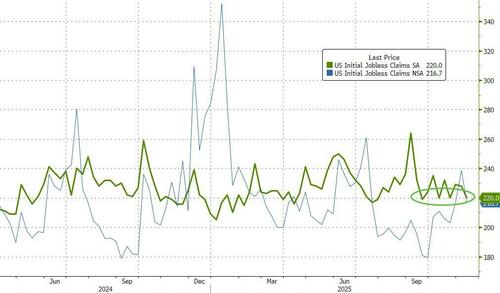
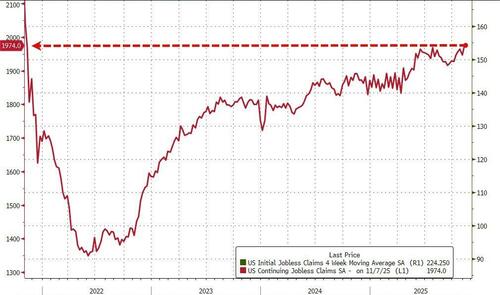





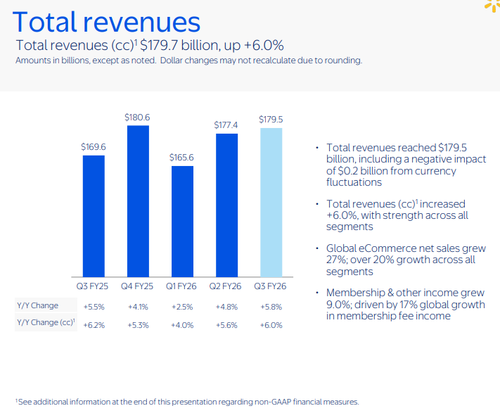
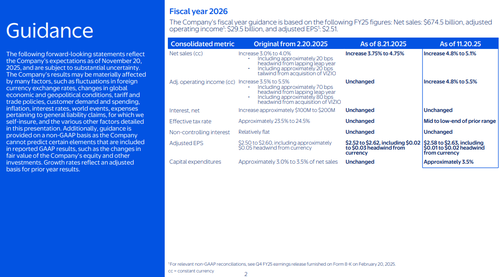
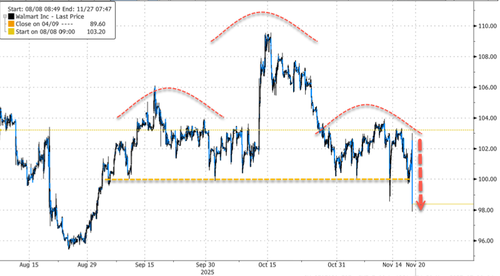
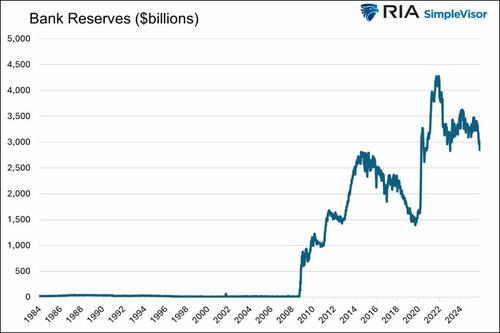
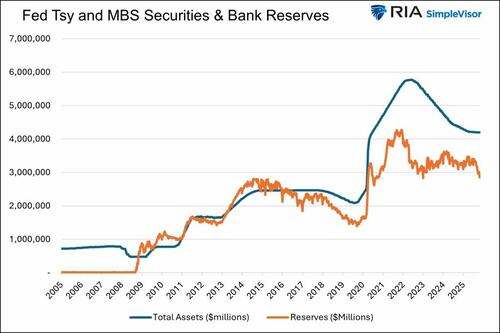
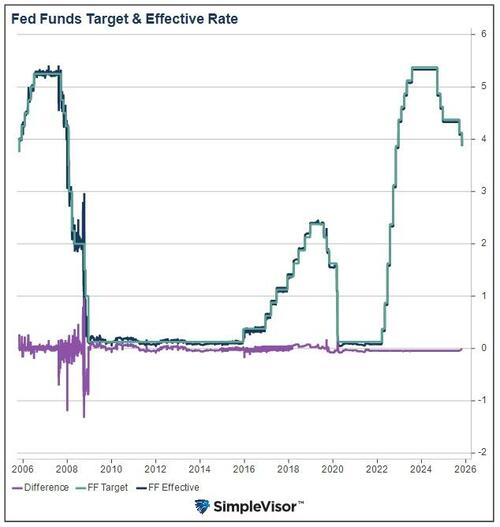

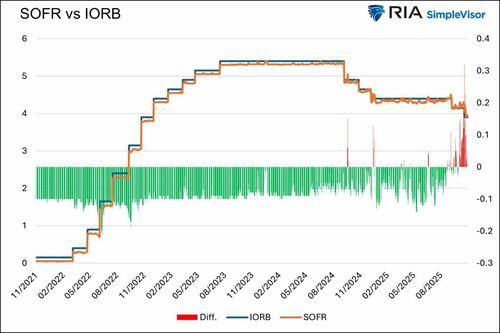

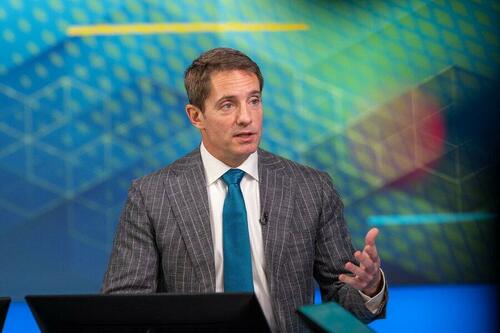
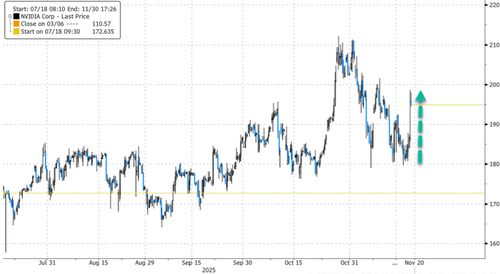
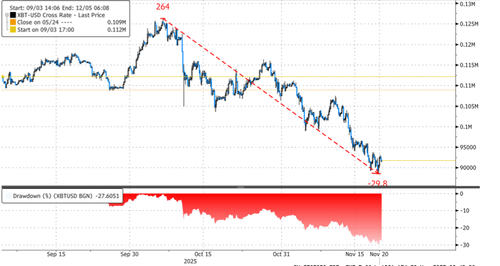
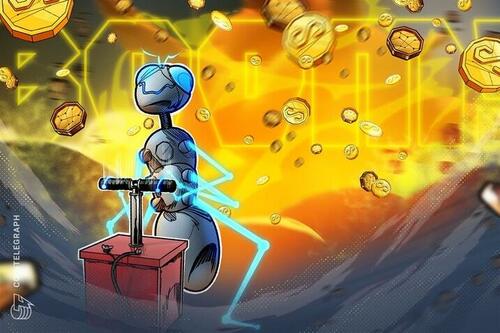

 AFP/Getty Images
AFP/Getty Images The Epoch Times/Shutterstock
The Epoch Times/Shutterstock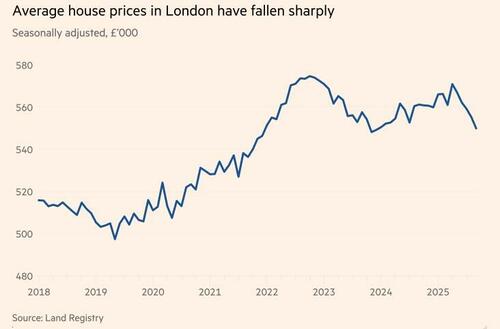
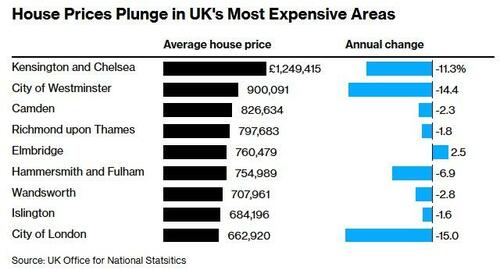
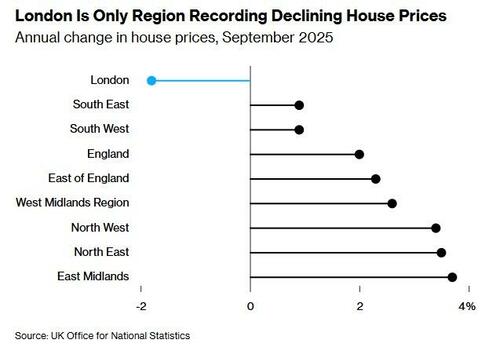



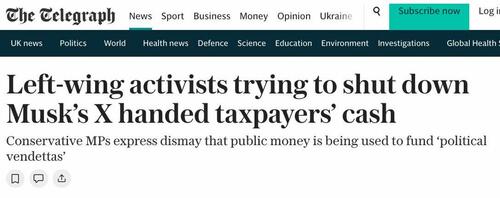
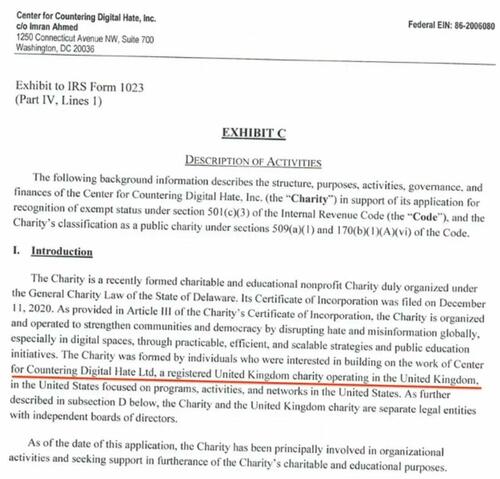




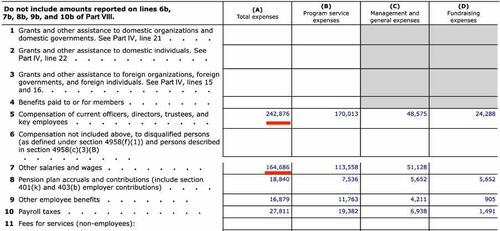



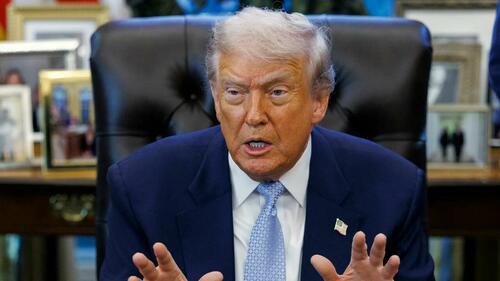
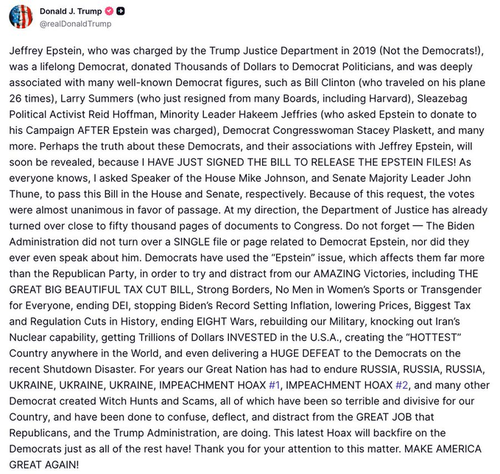

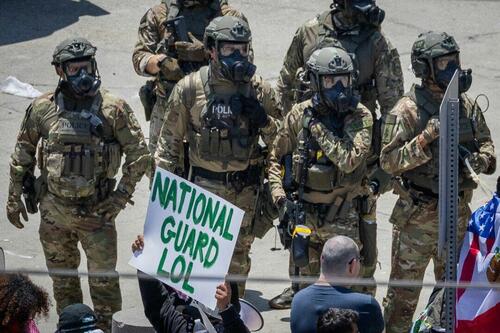 Immigration and Customs Enforcement agents form a defensive perimeter near an operations center in Los Angeles on June 8, 2025. John Fredricks/The Epoch Times
Immigration and Customs Enforcement agents form a defensive perimeter near an operations center in Los Angeles on June 8, 2025. John Fredricks/The Epoch Times
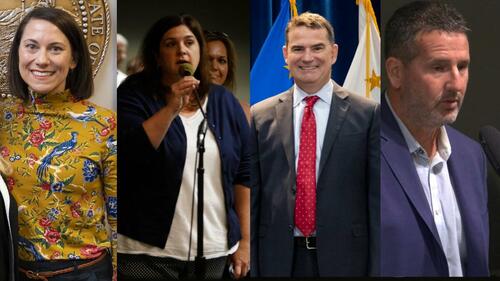
Recent comments